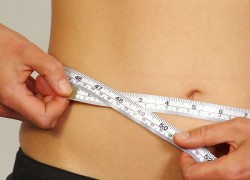Weights and Measures
Take a shower for low back pain
 Never underestimate the power of hot (but tolerable), surging water. If your pain is the sudden result of a wrenching strain, then wait 24 hours before applying hot water, to minimize inflammatory response.
Never underestimate the power of hot (but tolerable), surging water. If your pain is the sudden result of a wrenching strain, then wait 24 hours before applying hot water, to minimize inflammatory response.
Let the shower water pound your back at full force, as hot as you can tolerate it, for 15 minutes straight. Throughout this 15 minutes, stretch your back a little. Do this three times daily. You’ll experience significant improvement just after the first water session. Some pain and stiffness will always return after each shower session, but you’ll also notice that with each session, there will be less pain to start out with.
Avoid the dieting cycle for these reasons
Frequent dieting results when your “diet” is not something you can stick to for life. Dieting cycles can throw off metabolism, resulting in more weight gain once you go off the diet. A typical diet that’s difficult to stick to is one of too much calorie restriction.

An example would be skipping breakfast, having only a green salad and cottage cheese for lunch, then a piece of chicken, roll and apple for dinner, and maybe a few graham crackers and juice for a snack. Total calories: 1,000!
Do this long enough and your body may begin holding onto its fat, because 1,000 calories a day will be perceived by your body as some kind of famine. The body gears up for famine by clinging to fat reserves. Furthermore, you’ll probably lose some muscle tissue as well, since muscle tissue can supply the body with energy during the famine.
The scale says you’ve lost weight, but some of it will be muscle, which you need for an efficient metabolism! At some point you quite the diet and resume your normal 2,800 calories a day. But this time, your body has less muscle to burn calories at rest, and you end up becoming heavier with more fat than you had at the start of the diet.
Total cardio workouts without machines or equipment
Whether you are traveling, busy or just hate the gym, there are many simple ways to fit in your cardio without ever getting on a machine or taking a class.
Cardio can consist of jogging, walking, plyometric exercise (jumping), swimming, jump rope, etc.
Any activity that gets you sweating for more than 20-30 minutes a day can count towards your cardio. It does not have to be in a block of time either, you can do three 10-minute sets throughout your day if it’s easier.
Step aerobics with high platform (Step-ups)
This requires more conditioning than most people are used to, but go for it: Use four or five “risers” for your stepper platform. If 8-12 reps aren’t that difficult, use the higher height of an exercise stool. Hand weights are optional.
Wintertime doesn’t have to mean inertia
There’s plenty you can do during the cold and snowy months to keep your cardiovascular system and metabolism on fire, and your muscles well-toned and strengthened.
For example, on a snowy, bitter-cold day, set a timer for just 10-15 minutes, and do two of the following:
- Jump rope alternating with marching in place with high knees
- Stability ball squats against a wall alternating with pushups or jogging in place
- Briskly walking up and down your staircase two stars at a time, or running them
- Dumbbell upper body workouts
Overeating triggered by fewer pleasure receptors
Obese people have fewer pleasure receptors, and eat too much to compensate, says a study by University of Texas at Austin senior research fellow and Oregon Research Institute senior scientist Eric Stice and his colleagues, published in The Journal of Neuroscience (2010).
When you eat food, more of the neurotransmitter dopamine is releases. Pleasure from eating is directly proportional to amount of dopamine releases. Obese people have fewer dopamine receptors when compared to leaner people; this indicates that obese individuals overeat to make up for this deficit.
More food is required to reach the same reward that slimmer people (who have more dopamine receptors) require. However, this reward deficit gets amplified by overeating. The weakened responsively of the reward circuitry increase the risk for future weight gain in a feed-forward manner. This may explain why obesity typically shows a chronic course and is resistant to treatment.
Functional magnetic resonance imaging (fMRI) was used to measure brain responses to the intake of a chocolate milkshake, and study participants were tracked for six months.
Those who gained weight showed much less activation in a key area of the brain (dorsal striatum0 in response to the milkshake at the six-month follow-up, compared to their original brain scan, and relative to subject who did not gain weight.

